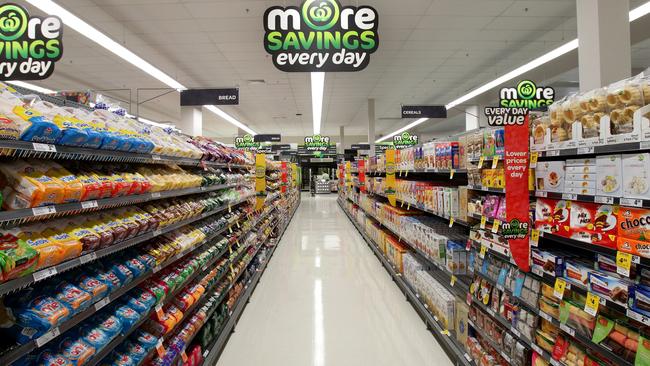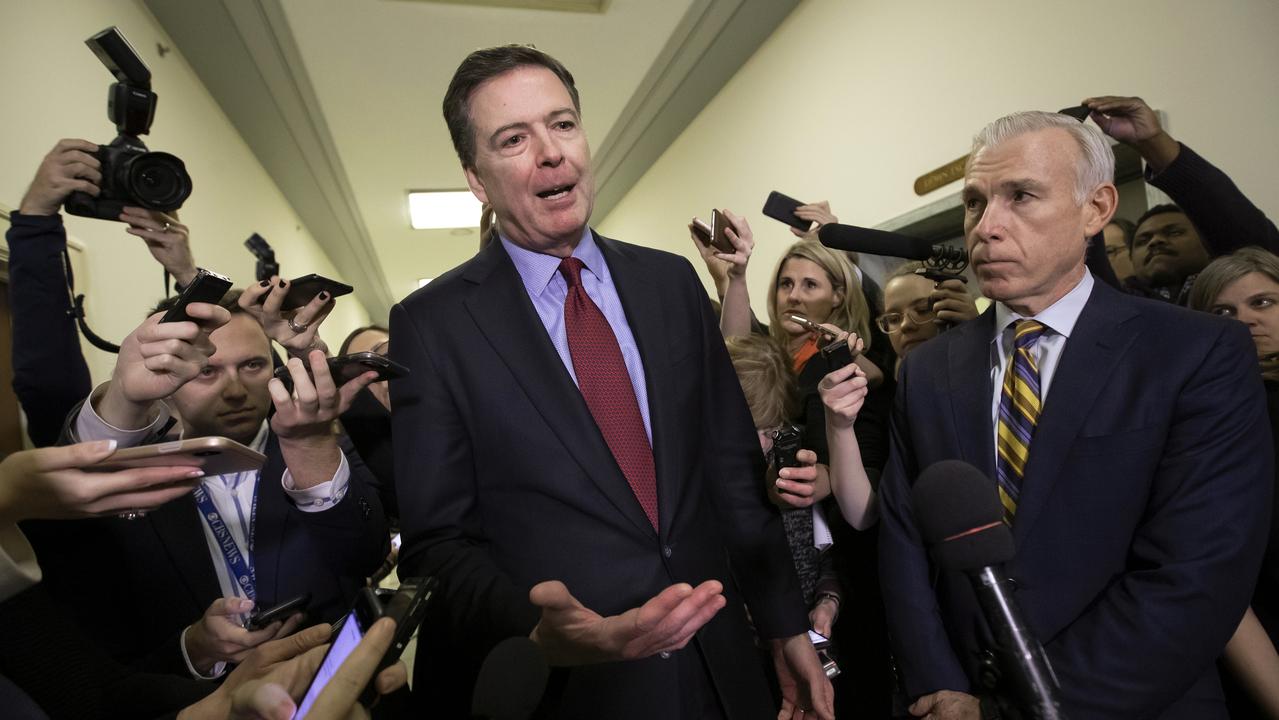Are supermarket giants simply too big?
THE ACCC is out to see if Woolies and Coles have crossed the line.

HIS hands quivered as he spilled the beans. Chatting with investigators from the Australian Competition & Consumer Commission, the grocery supplier was so nervous he started shaking.
“Nobody would talk to us about anything,’’ ACCC chairman Rod Sims recalls of the two-year investigation that culminated in the regulator’s prosecution of Coles supermarkets for allegedly bullying suppliers.
“Then we promised suppliers we would protect their confidentiality, and we got nearly 50 people who came through the door to talk to us. Some of them did so quivering — they were coming to us, trusting us to keep it confidential, but their livelihood was at stake.
“They were all worried about the consequences of talking to us. Our people with a lot of experience in this area had never quite seen this sort of reaction before.’’
The pledge of secrecy meant the ACCC could not use its suppliers’ information as evidence in its landmark case, which Coles is contesting in the Federal Court. Instead, the regulator is relying on “section 155’’ notices to procure documents and compel suppliers and supermarket executives to give evidence in a case that is expected to last all year.
The ACCC alleges that Coles demanded $16 million worth of “rebate’’ payments from 200 small and medium-sized suppliers — and threatened “commercial consequences’’ for those that refused to cough up.
It claims Coles “took advantage of its superior bargaining position’’ to exert “undue influence and pressure and unfair tactics’’.
Dozens of Australia’s best-known brands — Nestle, Red Bull, Procter & Gamble, Bonds and Oates among them — are named in the ACCC statement of claim, filed in the Federal Court last month.
A Coles spokesman said yesterday the company would “vigorously defend’’ the case but declined to comment further.
The ACCC has locked horns with the grocery giants several times this year.
In February, it prosecuted Coles and Woolworths over shopping dockets offering grocery customers generous discounts on fuel purchased from the supermarkets’ own petrol stations. The Federal Court cleared Coles but ruled that Woolworths had breached a court-enforceable undertaking, which was rectified in March.
Then, in April, Coles agreed to publish corrective advertisements after the ACCC investigated farmers’ complaints about a YouTube video that falsely claimed farmers had been paid more for their milk since Coles slashed the retail price to $1 a litre.
This week, the Federal Court ruled that Coles misled consumers by claiming that frozen bread imported from Ireland had been “freshly baked in-store’’. And AusVeg complained to the ACCC this month after Woolworths asked vegetable growers to contribute money towards the cost of Jamie Oliver’s celebrity-chef endorsement. Woolworths insists the 40c-a-crate payment is “entirely voluntary’’.
Sims denies the ACCC is picking on the big supermarkets. “It’s unquestionable there are more complaints,’’ he tells Inquirer. “We’re not searching for these cases, for goodness sake. When we get another supermarket issue walk in the door we say, ‘Oh no, not another one!’ ’’
Disquiet over the grocery giants’ growing market power prompted independent senator Nick Xenophon to introduce legislation, which is before the Senate economics legislation committee, which would empower the Federal Court to force a corporation to sell down its market share if it is found to have misused its market power.
“The fight to the death between Coles and Woolies is like two big gorillas fighting in a room,’’ Xenophon tells Inquirer. “In their fight for market share, they are leaving collateral damage; the ones who get hurt are the farmers and food producers. I don’t think they are inherently bad people — it is a function of their market power.’’
For every $100 Australians spend on groceries, about $70 ends up in a Coles or Woolies cash register. Once fresh meat, fruit and vegetables are included, the figure drops to about $50, based on the ACCC’s estimates.
Industry analyst IBISWorld calculates that Woolworths holds a 41.4 per cent share of the $87 billion grocery market, with Coles holding 32.5 per cent. Fast-growing rival Aldi holds just less than 5 per cent, while IGA holds about 19 per cent. Supermarkets are just the tip of the iceberg: their parent companies dominate Australia’s retail landscape.
A loyal customer can feed the family, fill up the car, clothe the kids, landscape the back yard and relax with a beer without spending a cent with a rival retailer.
Wesfarmers boasts 756 Coles supermarkets, 810 bottle shops, 636 petrol stations and convenience stores, 92 hotels, 313 Bunnings Warehouse hardware stores, 150 Officeworks stores, 190 Kmart and 308 Target chain stores, and 263 tyre and car servicing centres. It recently branched out into cut-price insurance and is flirting with a move into banking.
Woolworths Ltd owns 897 supermarkets, 181 Big W chain stores, 1355 bottle shops, 323 hotels, 31 Masters hardware stores, 613 petrol stations and 50 optometry outlets. Its property development division has built 100 shopping centres.
Together, the conglomerates employ 400,000 Australians, one in three of the nation’s retail workers. In some cases their clout has improved the range and quality of food: Coles mandated hormone-free beef and RSPCA-approved chickens, banned sow-stall pork from its home-brand range, reduced salt in its breakfast cereals, and removed MSG and artificial colours from private-label goods.
Woolies championed gluten-free products and Meat Standards Australia-certified beef and lamb, and is phasing out the sale of eggs from battery hens. Both supermarkets source all their fresh meat, and more than 90 per cent of their fresh fruit and vegetables, from Australia.
Woolies has price-cut more than 1000 essential items, while Coles has cut the cost of 1400 grocery items in its catchy “Down Down’’ campaign. Woolworths Ltd calculates the supermarkets’ five-year price war has saved Australian households $2200, or $445 a year.
“This is equivalent to about 20 basis points off a typical Australian mortgage,’’ a Woolworths Ltd spokeswoman tells Inquirer. “In the last five years, food and non-alcoholic beverage price (increases) have tracked at 1.3 per cent compared to inflation at 2.6 per cent, so that means that real food prices have fallen … by $17bn.’’
Part of the price cuts come from the supermarkets’ growing use of cheaper home-brand or “private-label’’ products, often with a striking similarity to big-name brands. Kellogg’s Rice Bubbles is stacked beside Coles Rice Puffs, in similar blue boxes.
Arnott’s Jatz crackers are sold alongside Woolworths Snapz, while its Tiny Teddy biscuits jostle with Woolies’ Little Bears. The Woolworths spokeswoman says private labels make up just 6 per cent of the supermarket’s range and 11 per cent of sales.
But Tony Pititto, who heads the food, beverage and agribusiness industry team at accounting firm Grant Thornton, estimates that 25 per cent of Australian groceries — including those sold by Aldi — are private-label products, compared with 15 per cent five years ago.
“Power has certainly shifted to the retailer,’’ he says. “The big problem for suppliers is that once they start (manufacturing for) private label, they don’t have the brand strength. It’s all about the lowest price, so if I’m producing biscuits for $2 a packet and the supermarket wants it at $1.80 they’ll just go to someone else. If I’m a strong brand, they can’t get that product from someone else.’’
A new KPMG analysis, commissioned by the Australian Food and Grocery Council, estimates that $1 in every $4 earned by suppliers is being handed back to retailers to pay for discounts, rebates and promotions. It claims that Coles and Woolworths extract 5 per cent more from suppliers than do rival retailers.
Several suppliers have told Inquirer, on condition of anonymity, that supermarkets insist they foot the bill for promotions, so the manufacturer and not the retailer loses money when products are sold in half-price specials.
Suppliers claim they have to pay to be featured in a catalogue or advertisement, and are charged “slotting fees’’ for premium shelf space.
Manufacturers and suppliers fear the supermarket will stop stocking their product unless they comply.
“They never say blatantly they will delete you, but we all know that person sitting in that (buyer’s) seat has all the power to make or break your business,’’ explains the owner of one supplier, whose product has been replaced with private labels in both supermarket chains. “Eighty per cent of your turnover comes from Coles and Woolies.”
Another supplier explains how brands are “lined up for deletion’’. “They just diminish your shelf placement,’’ he says. “Then they say you’re not performing as well as you used to, and eventually you’re off the shelf.’’
Suppliers hope a new industry code of conduct — endorsed by the supermarkets and awaiting federal government approval to become legally binding — will level the playing field. The code will ban retrospective changes to contracts, and stop supermarkets from charging suppliers for shrinkage or wastage when goods are damaged in-store.
Retailers will be prohibited from charging suppliers to have their product stocked, or displayed in a certain shelf space, apart from promotions or “specials’’.
Products can be delisted only for “genuine commercial reasons’’, such as quality problems or failing to meet pre-agreed sales targets.
Supermarkets must “respect all intellectual property rights’’, including established brands’ distinctive packaging, when they create private-label rival products.
The grocery giants’ dominance is also being examined in the Abbott government’s competition-policy review, the first since Fred Hilmer’s inquiry two decades ago. Wesfarmers has told the review, chaired by economist Ian Harper, that “big is not bad’’.
“In fact, size and scale bring substantial benefits through efficiencies that lead to lower prices,’’ it states in its submission. “Without sufficient scale, many Australian businesses will find it exceedingly difficult to compete and survive against international entrants that have scale which dwarfs even the largest Australian firms.’’
Sims thinks the Xenophon bill’s proposed divestiture powers would be “an awfully big stick to use’’.
But he does appear to champion changes to section 46 of the Competition and Consumer Act, which prohibits a corporation with a “substantial degree” of market power from using it “for the purpose of’’ eliminating or damaging a competitor, or preventing or deterring competition.
A new “effects test’’ would let the ACCC prosecute companies over the misuse of market power that has the effect of damaging a rival, without needing to prove that the damage was deliberate.
Sims insists that size is not the problem. “Of course big is not bad,’’ he says. “But if you’re using your position to exclude others from the market, that’s where you cross the line. We’re not out to penalise big companies but the bigger you get, the more you have to ensure you don’t engage in exclusionary conduct.’’



